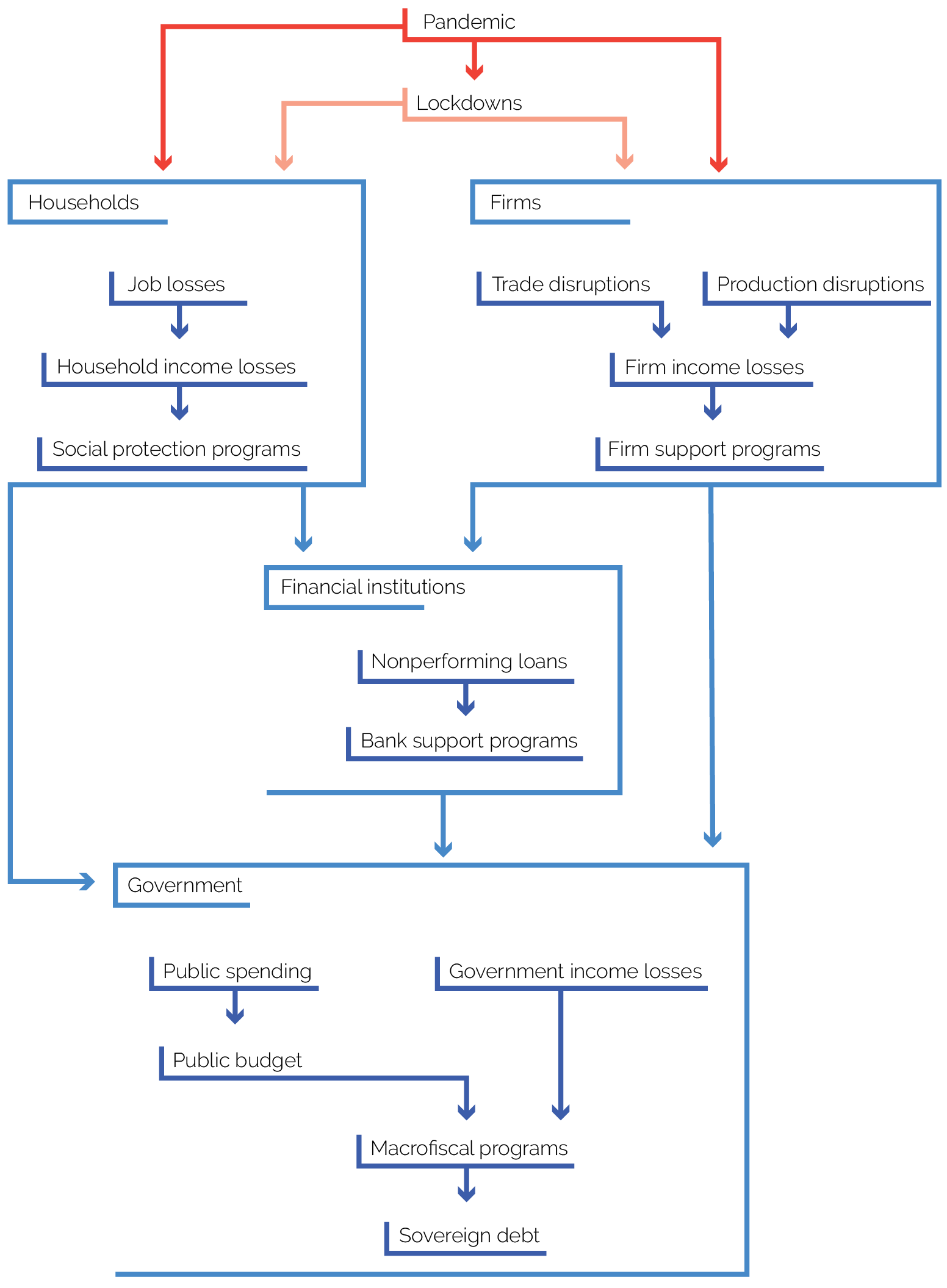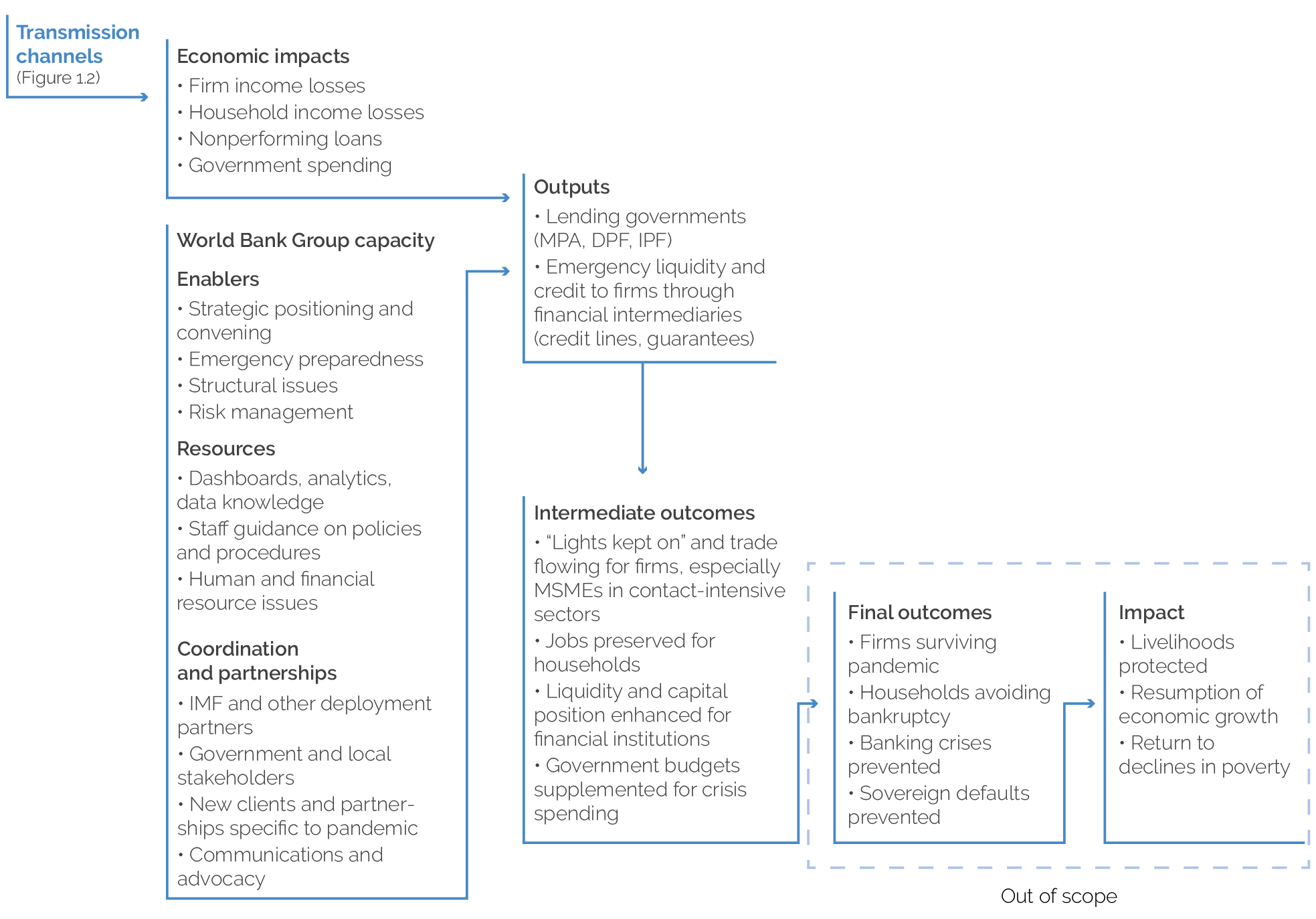The World Bank Group’s Early Support to Addressing the Coronavirus (COVID-19): Economic Response (April 2020-June 2021)
Chapter 1 | Background and Context
Highlights
The economic problems intertwined with the COVID-19 pandemic are markedly different from past economic crises in their origins, scope, and timing. They threaten all Sustainable Development Goals, especially Sustainable Development Goal 1 (end poverty) and Sustainable Development Goal 8 (promote economic growth and shared prosperity). They are also causing a rapid buildup of sovereign debt.
The crisis resulting from the pandemic, which caused direct economic losses of approximately $7.4 trillion in 2020 alone, has had deep economic impacts through numerous transmission channels affecting firms (trade and production disruptions), households (job and income losses), financial institutions (nonperforming loans), and governments (public spending, income losses, and sovereign debt). The World Bank Group has drawn on its full capacity to respond to urgent issues with support to public budgets, bank liquidity, firm solvency, and trade during both the acute crisis phase in 2020 and the incipient recovery phase in 2021.
The objective of the evaluation is to foster learning and adaptive management to strengthen the Bank Group’s ongoing response to the economic dimensions of the pandemic and help it prepare strategically and institutionally for early responses to future crises. This early-stage evaluation builds on and adds to previous and ongoing Bank Group efforts to learn from crises, including The World Bank’s Early Support to Addressing COVID-19: Health and Social Response, a parallel evaluation of the World Bank’s early response to the health, human capital, and social protection emergencies related to COVID-19. This evaluation will be complemented by a future ex post evaluation.
The main evaluation question is, “How well did the Bank Group respond to global, country, and firm needs in its early response to the COVID-19 economic crisis?” We assessed both the relevance of the Bank Group response (how well it was tailored to countries’ and sectors’ needs and the Bank Group’s comparative advantages) and its quality (the extent to which it influenced governments and firms, was well coordinated, and maintained adequate monitoring, safeguards, and governance).
We used a mixed methods approach, including a structured literature review, case-based analysis, key informant interviews, portfolio review and analysis, and econometric and comparative analysis. The evaluation applies a “learning for adaptive management at the time of a crisis” lens to its quality assessment, aimed at understanding whether the Bank Group applied lessons learned from its own work during the crisis (intracrisis learning).
The evaluation has several limitations because of its scope and its nature as a real-time learning evaluation.
The Economic Impact of the COVID-19 Pandemic
The COVID-19 economic crisis is markedly different from past crises. There have been previous public health crises (such as the Ebola crisis, which was more regional but had a large impact), but the economic dimensions of the COVID-19 crisis are unprecedented. First, unlike many past economic crises, the COVID-19 economic crisis did not arise because of macroeconomic or financial imbalances but because of a worldwide health crisis that halted economic activities. Second, COVID-19 affected both supply and demand, whereas financial crises are demand shocks (Benguria and Taylor 2020). The two processes were mutually reinforcing, creating a downward spiral. Finally, the COVID-19 economic crisis hit most countries and sectors of the economy simultaneously.
The economic problems intertwined with the COVID-19 pandemic threaten the realization of World Bank strategic goals and the Sustainable Development Goals (SDGs). The World Bank (2020d) estimates that between 88 million and 115 million people were pushed into extreme poverty in 2020 because of the pandemic. The economic burden of the pandemic and its impact on government spending threaten all SDGs because they threaten the means of implementation. Poverty reduction (SDG 1, “end poverty in all its forms everywhere”); economic growth and shared prosperity (SDG 8, “promote sustained, inclusive, and sustainable economic growth, full and productive employment, and decent work for all”); and progress on debt relief and debt resolution (SDG 17, “revitalize the Global Partnership for Sustainable Development”) are especially at risk.1
The economic impact of the pandemic has been enormous. In 2020 alone, world gross domestic product (GDP) shrank by 3.3 percent (World Bank 2022b). However, before the pandemic, the economy was forecast to grow by 2.5 percent in 2020 (World Bank 2020c). Thus, the pandemic slashed GDP by approximately 5.8 percent just in 2020 (figure 1.1). The impact is equivalent to approximately $7.4 trillion, or four times the GDP of Sub-Saharan Africa (2020). For longer periods, the costs are higher: the International Monetary Fund (IMF) forecast that the COVID-19 pandemic will cost the global economy $12.5 trillion through 2024. Moreover, these estimates include only direct economic losses. They omit the economic effects of premature deaths, declining health (including mental health), reduced quality of life, and deterioration in human capital caused by job losses and school closures. Each of these factors increased the cost of the pandemic by trillions of dollars (Cutler and Summers 2020). Finally, the massive debt that governments and firms took on to weather the pandemic may dampen future economic growth and have far-reaching social costs (box 1.1).
Figure 1.1. Change in Gross Domestic Product and Gross Domestic Product Growth from 2019 to 2020 by Region

Source: World Development Indicators.
Note: EAP = East Asia and Pacific; ECA = Europe and Central Asia; GDP = gross domestic product; LAC = Latin America and the Caribbean; MENA = Middle East and North Africa; pp = percentage points; PPP = purchasing power parity; SAR = South Asia; SSA = Sub-Saharan Africa; WLD = World.
In parallel, the world is witnessing a rapid buildup of sovereign and corporate debt, especially in highly indebted countries. Sovereign debt in many emerging and developing economies has been trending upward since the early 2010s. The COVID-19 crisis has accelerated the pace of borrowing globally because sovereign nations have undertaken massive debt to support firms and citizens during the crisis (box 1.1). At more than 65 percent of GDP, emerging markets government debt is now 25 percentage points higher than in 2010 and continues to increase, with many countries running persistently large budget deficits (Gudmundsson et al. 2022). The rapid buildup in emerging market sovereign debt levels has greatly increased the likelihood of further debt strains. Sri Lanka defaulted in May 2022, and sovereign defaults are looming on the horizon for highly indebted countries such as South Sudan and Zambia (IIF 2022). The massive debt that governments and firms took on to weather the pandemic may dampen future economic growth and have far-reaching social costs, even in countries that do not default.
Box 1.1. Sovereign Debt and COVID-19
Sovereign debt was high even before the COVID-19 pandemic. Many emerging economies entered the pandemic with record levels of sovereign debt. By 2019, approximately half of the countries eligible for International Development Association assistance were in or at high risk of debt distress.
Global debt surged as a result of the COVID-19 pandemic. Countries took on additional debt to pay for programs to limit the pandemic’s economic and human costs. Average total debt burdens among low- and middle-income countries increased by roughly 9 percent of gross domestic product during 2020, compared with an average of 1.9 percent per year over the previous decade (figure B1.1.1).
Figure B1.1.1. General Government Gross Debt, by Country Income Group, 2010–20
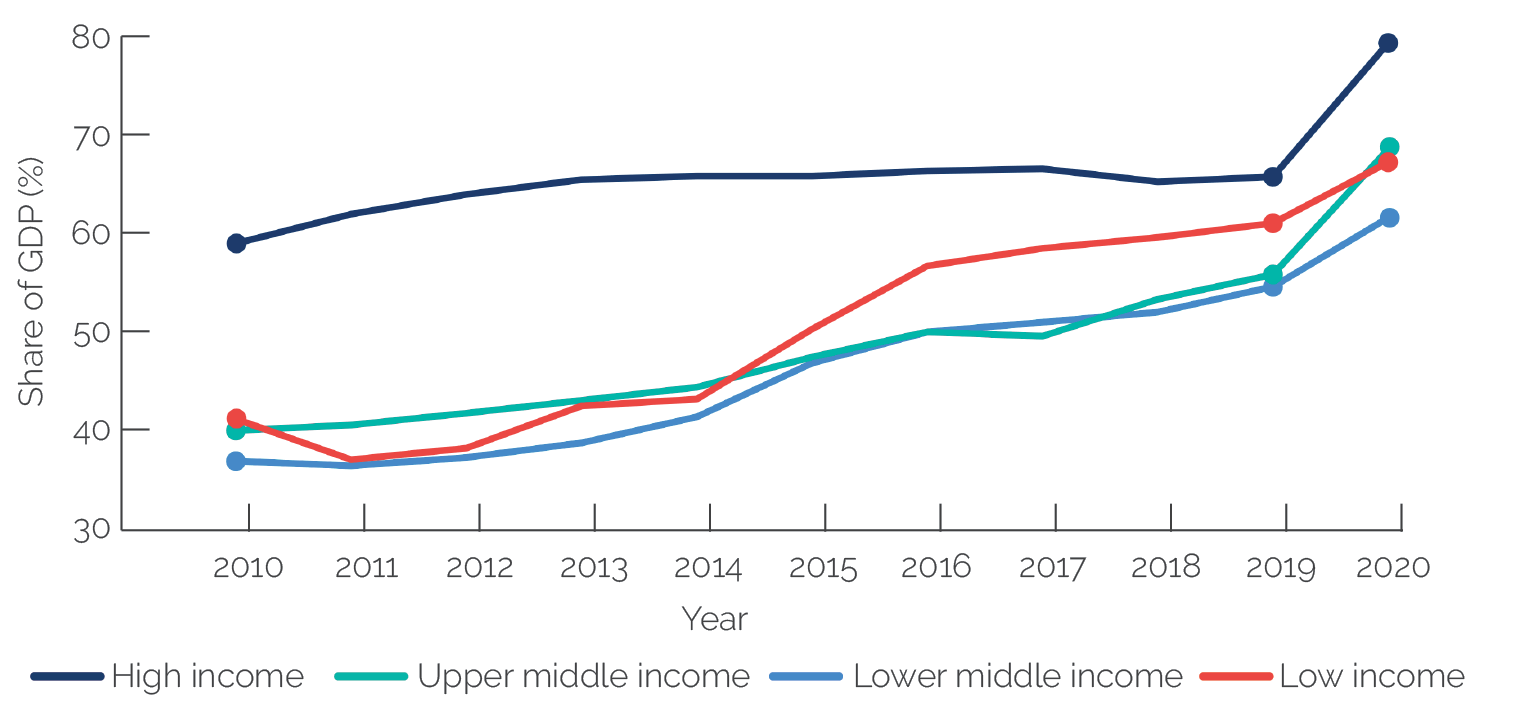
Source: World Bank 2022e.
Note: The figure shows the general public debt stock as a share of the gross domestic product by World Bank income classification. GDP = gross domestic product.
Because of these vulnerabilities, the global community will need to stand ready to provide debt relief equitably and efficiently. Managing and resolving elevated levels of sovereign debt are essential to ensuring an equitable recovery from the COVID-19 crisis. Sovereign debt crises are costly for sustained growth—every year a country remains in default reduces its gross domestic product growth by an estimated 1–1.5 percentage points. High sovereign debt also has far-reaching social costs. High sovereign debt reduces a government’s ability to spend on social safety nets and public goods such as education and public health. These consequences are typically borne disproportionately by vulnerable populations, low-income households, and small businesses and tend to worsen preexisting poverty and inequality.
Sources: Borensztein and Panizza 2009; Economist 2022; World Bank 2022b, 2022e.
The economic effects of the COVID-19 pandemic materialized through multiple channels (figure 1.2). Both the pandemic and the lockdowns prevented firms from operating and interrupted trade flows, creating a sudden and deep supply shock. Household income and investments fell quickly as workers lost their jobs or had their hours cut, which in turn constrained demand for goods and services. The massive, combined supply and demand shocks created a downward spiral, eventually affecting banks’ balance sheets through the rise of nonperforming loans, some of which become liabilities for governments. Government budgets were affected primarily through the simultaneous drop in revenues and pressures to increase expenditures on social protection, unemployment benefits, and subsidy programs aimed at supporting recovery for the most affected micro, small, and medium enterprises (MSMEs). Some contact-intensive sectors of the economy were particularly affected by the crisis, including tourism, manufacturing, construction, education, and retail services. Many small countries and island nations relying heavily on tourism lost precious export earnings and government revenues when their economies most needed fiscal support. Commodity exporters were affected similarly by the collapse of commodity prices.
Figure 1.2. Main Transmission Channels of the COVID-19 Economic Crisis
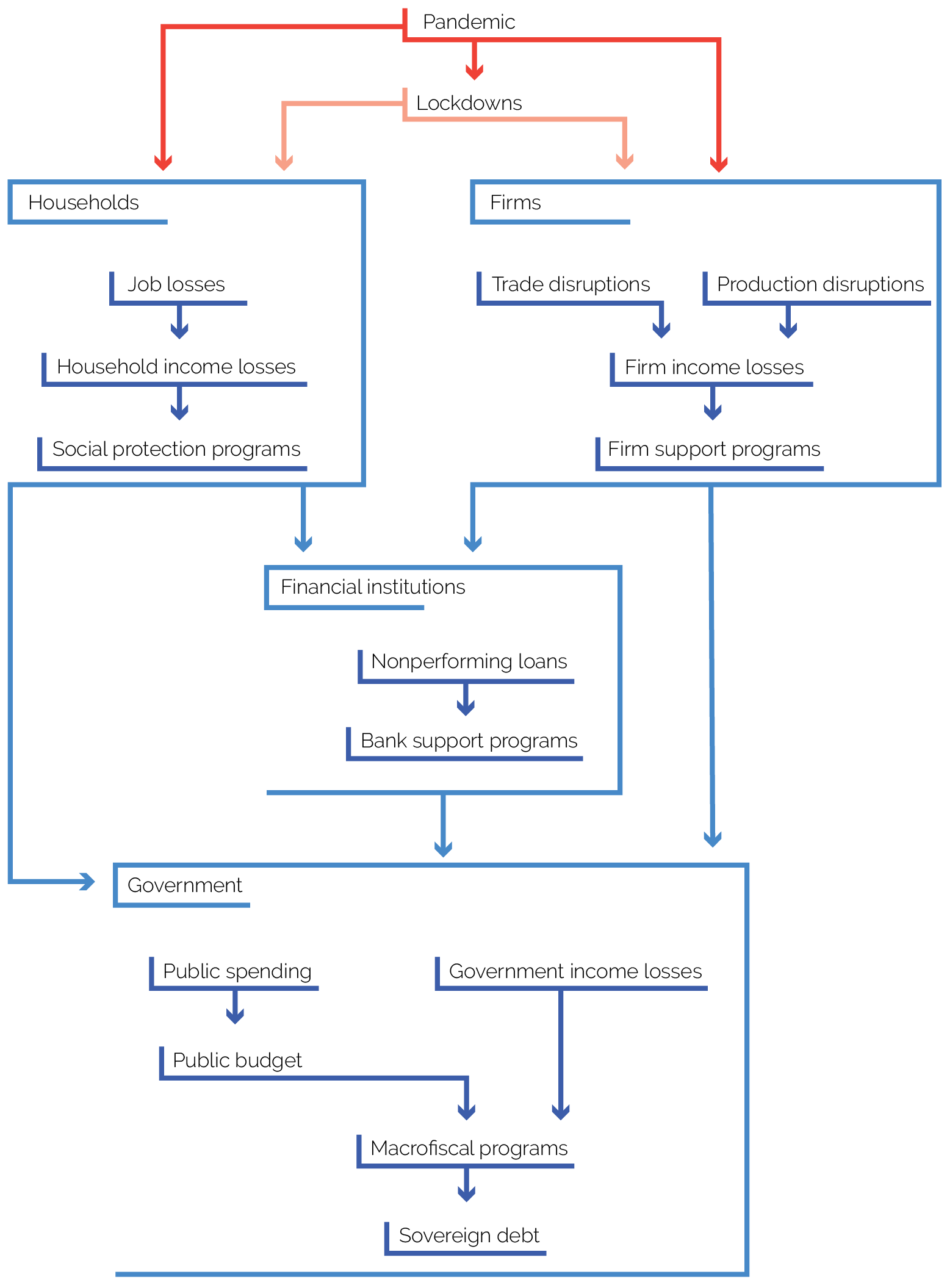
Source: Independent Evaluation Group.
The World Bank Group Response
The World Bank Group applied its full capacity to mitigating the economic impacts of the pandemic (see the theory of change in figure 1.3). Bank Group capacity included enablers such as the Bank Group’s strategic positioning and convening, its emergency preparedness, and its risk management practices. It also included resources such as data, analytics, and knowledge as captured in dashboards, among other means; policies and procedures; and human and financial resource management. Finally, Bank Group capacity included coordination and partnerships with the IMF and other development partners, government and local stakeholders, and new clients and partnerships to address the pandemic.
Bank Group interventions targeted governments, financial institutions, and firms. The World Bank provided development policy financing (DPF) to help governments cope with the crisis and improve the transparency of governments’ macro and fiscal measures during the COVID-19 crisis and beyond. The International Finance Corporation (IFC) provided emergency liquidity and credit to firms through financial intermediaries (such as credit lines and guarantees). IFC and the Multilateral Investment Guarantee Agency (MIGA) developed lending envelopes and guarantee programs to provide fast disbursement or coverage options to financial institutions and firms affected by the pandemic and the lockdowns. Together, these Bank Group operations addressed the immediate needs of MSMEs—especially those in contact-intensive sectors—to “keep the lights on” and thereby save jobs, enhanced the liquidity and capital position of financial institutions, and supplemented government budgets for crisis spending. On the basis of these intermediate outcomes, we expect that the final outcomes would be reducing firm and household bankruptcies and preventing banking crises and sovereign defaults, with the ultimate impact of protecting livelihoods during the COVID-19 emergency, returning to economic growth, and resuming declines in poverty. However, final outcomes and impact are out of scope for this early-stage evaluation.
Figure 1.3. Theory of Change for World Bank Early Response to Economic Implications of COVID-19
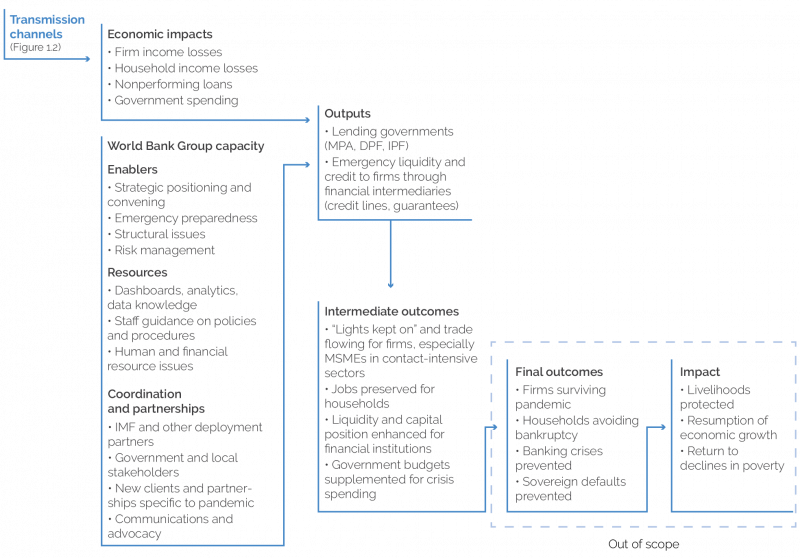
Source: Independent Evaluation Group.
Note: DPF = development policy financing; IMF = International Monetary Fund; IPF = investment project financing; MPA = Multiphase Programmatic Approach; MSME = micro, small, and medium enterprise.
With support from the Bank Group and other sources, most countries progressed from the acute crisis phase to the incipient recovery phase during the evaluation period. The acute crisis phase was marked by widespread lockdowns and steep dives in economic growth. The incipient recovery phase was marked by the easing of lockdowns and the resumption of economic growth. The resumption of economic growth largely occurred in the first half of 2021. For instance, growth returned to positive territory by first quarter of 2021 in Nigeria and Serbia (case study countries for this evaluation) and in Mozambique and Zambia (heavily indebted countries), and it rebounded by the second quarter of 2021 in Georgia and the Philippines (also case study countries). By the end of the evaluation period (June 2021), nearly every client country had also eased restrictions from their peak stringency, as measured by the Oxford Stringency Index.2 In Serbia and Zambia, lockdowns were eased as early as June 2020, in Georgia by August 2020, in Nigeria by November 2020, and in Mozambique and the Philippines by January 2021. Some countries reimposed more stringent restrictions later in the pandemic, but few returned to the level of stringency of second quarter 2020. Nearly every country had both resumed economic growth and loosened lockdowns by June 2021.
Objective and Scope of the Evaluation
This evaluation assesses the relevance and quality of the Bank Group’s early response in addressing the economic implications of COVID-19. Its purpose is to foster learning and adaptive management to strengthen the Bank Group’s response to the economic dimensions of the COVID-19 crisis—protecting livelihoods—and help the Bank Group prepare for future crises.
This evaluation covers the Bank Group’s early response to specifically address the economic implications of COVID-19. It examines Bank Group interventions over the 15-month period from April 1, 2020, to June 30, 2021. Although the case studies cover the whole evaluation period, the portfolio analysis considers a subset of the evaluation period, from April 2020 to April 2021.3 For assessment of intracrisis learning, the first part of the evaluation period (the acute crisis phase) is defined as April 1 to December 31, 2020. The second part of the evaluation period (the incipient recovery phase) is defined as January 1 to June 30, 2021. As described in the previous section, the two phases were identified based on the Oxford Stringency Index and country-level economic indicators (including GDP). Although the distinction is preliminary and has limitations (described in the next section), it allows making an early assessment of whether the Bank Group internalized learning from the acute phase of the crisis to address the challenges that were materializing in the (incipient) recovery phase.
An assessment of the Bank Group’s early response to the COVID-19 crisis is important for informing the recovery phase of the response to this crisis and early responses to future crises. The world is still developing an optimal policy response to COVID-19 economic implications, where the aim is to preserve economic value to the extent possible and keep physical capital and essential productive assets intact via macroeconomic, financial, and fiscal support. On this basis, a stocktaking of the Bank Group response at this early point—including successes and failures and overall consistency among Bank Group interventions and its comparative advantages—is warranted to support the next set of support efforts to address the COVID-19 crisis and to prepare for future crises. We offer findings, lessons, and recommendations to promote learning within the Bank Group overall. They are intended to be applied at a strategic and institutional level, not to provide ready-made solutions for the unique challenges of specific operations or projects.
Evaluation Questions, Methods, Limitations, and Links with Other Evaluations
The overarching evaluation question is, “How well did the Bank Group respond to global, country, and firm needs in its early response to the COVID-19 economic crisis?” The report seeks to address this overarching question by assessing the relevance and quality of the Bank Group response as articulated in the following two evaluation questions:
- What has been the relevance of the Bank Group COVID-19 response in addressing the economic needs of clients, and what lessons can be drawn?
- Tailored approach. In what ways and to what extent did the Bank Group tailor its response to country conditions?
- Design. To what extent was the Bank Group support to help clients address economic vulnerabilities informed by timely diagnostics, lessons from past crises, and understanding of trade-offs?
- Comparative advantage. To what extent did the Bank Group use its comparative advantages (for example, by developing and sharing knowledge; by leveraging internal synergies among the World Bank, IFC, and MIGA; and by convening partners) to tailor its client response?
- What has been the quality of the early Bank Group COVID-19 response to address the economic needs of clients, and what lessons can be drawn?
- Influence. To what extent have Bank Group interventions influenced government policies and the actions of governments and firms?
- Coordination. How well has coordination within the Bank Group, between the Bank Group and the IMF, and between the Bank Group and other partners supported the design and delivery of Bank Group interventions?
- Monitoring and governance. To what extent do Bank Group support efforts have adequate results frameworks, safeguards, and governance?
We used a mixed methods approach. The methods included a structured literature review, case-based analysis, key informant interviews, portfolio review and analysis, and econometric and comparative analysis. The econometric and comparative analysis consisted of combining the coded portfolio data with data from public sources on COVID-19 (on countries’ situations and needs, including vulnerabilities, preparedness, capacities, socioeconomic impact, response, and spread of the virus) and using the combined data to select cases and address the relevance of the Bank Group’s response to the crisis, given countries’ needs.
We studied the relevance and quality of the Bank Group response to the COVID-19 crisis at three levels: global, countries, and firms. At the global level, the units of analysis are Bank Group global support efforts, including establishment of partnerships and development of real-time knowledge on the economic implications of the COVID-19 crisis. We assessed these global support efforts and their contributions to the relevance and quality of the response across the three institutions of the Bank Group.
We studied the relevance of the Bank Group response on three dimensions. The relevance criterion assesses whether interventions are doing the right things (OECD DAC Network on Development Evaluation 2019). For the purpose of early-stage assessment, we assessed relevance in three ways: (i) evidence of a targeted approach based on the needs of the clients; (ii) the extent to which the targeted support was informed by timely diagnostics, lessons from past crises, and understanding of trade-offs; and (iii) the extent to which the Bank Group used its comparative advantages to tailor the response.
We used three dimensions to study the quality of the Bank Group response. Quality is not strictly an evaluation criterion and is typically assessed as part of effectiveness. We did not comprehensively assess the effectiveness of the Bank Group responses to countries and firms because it is too early to do so. We do, however, provide evidence of the quality of Bank Group actions when available. Given the early-stage nature of this evaluation, we studied the quality of the Bank Group response on three dimensions: (i) the extent to which the Bank Group response influenced client strategies in response to the pandemic; (ii) the extent of coordination within the Bank Group, with the IMF, and with other development partners; and (iii) the extent of monitoring, safeguards, and governance frameworks in place.
In evaluating the quality of the Bank Group’s response, we assessed its ability to learn and apply lessons in real time, including from its own work (intracrisis learning). To evaluate the quality of the Bank Group’s response to COVID-19, we assessed whether the Bank Group was learning lessons derived from its COVID-19 work as the crisis unfolded (intracrisis learning). The intracrisis learning assessment complemented a more traditional assessment of whether the Bank Group applied to its COVID-19 work lessons learned from previous crisis and real-time lessons from developed countries’ approaches to COVID-19. To assess intracrisis learning, we used the principles of adaptive management and crisis learning. Adaptive management is collecting, sharing, and studying data from ongoing efforts to identify and understand the drivers of results, then adapting processes to continually improve an organization’s ability to achieve the desired results (Moynihan 2009; appendix B). Adaptation should occur both during execution (adjusting course based on evidence) and during planning (setting the course for new efforts based on evidence). Crisis learning is adaptive management applied to the management of crises. Effective crisis response maintains what works well, expands resources as necessary, pivots to address new challenges, innovates, and increases risk appetite judiciously. We embedded these principles in our assessment of the quality of the Bank Group response to the crisis.
The evaluation was developed in close coordination with a parallel Independent Evaluation Group (IEG) evaluation focused on protecting lives, The World Bank’s Early Support to Addressing COVID-19: Health and Social Response, and with an IMF evaluation of the IMF’s early response to the pandemic. IEG has conducted an evaluation that focuses on assessing the World Bank’s early response to support governments’ responses to the health, human capital, and social protection emergencies related to the COVID-19 crisis. The two IEG teams have collaborated closely, especially on country case studies, by jointly engaging with clients and stakeholders. We have also coordinated findings and messages, to the extent possible, with the IMF evaluation team that has conducted a review of the IMF’s early response to the COVID-19 pandemic at the country level by jointly engaging with clients and stakeholders regarding macrofiscal response.
The evaluation adds to previous Bank Group efforts to learn from crisis support. These efforts include the synthesis report Crisis Response and Resilience to Systemic Shocks: Lessons from IEG Evaluations and the evaluations The World Bank Group’s Response to the Global Economic Crisis: Phase I and Phase II, and The World Bank Group and the Global Food Crisis: An Evaluation of the World Bank Group Response. The evaluation also leverages evidence gathered through just-in-time notes and validations on trade finance, support to small and medium enterprises in times of crisis, and distressed assets management. See appendix A for more details.
The evaluation has limitations because of its scope. The evaluation focuses on assessing the Bank Group’s response to the economic implications of the COVID-19 crisis (“the impact of the crisis on livelihoods”). As mentioned earlier, it was developed in concurrence with—and it is complemented by—an evaluation of the World Bank’s health, human capital, and social response to the COVID-19 crisis (which focuses on “the impact of the crisis on lives”). Neither evaluation assesses the World Bank’s, IFC’s, or MIGA’s overall corporate response to the crisis. Rather, they look at the Bank Group’s response on selected topics. For example, activities under the IFC Global Health Platform are outside the scope of this evaluation because the underlying projects are related to the health sector. Moreover, none of the projects financed by the Global Health Platform would have met the selection criteria for case studies. The decision to have two separate reports stemmed from the recognition that assessing the Bank Group’s work on both lives and livelihoods in a single evaluation would have limited the depth of the analysis. Both evaluations will be complemented by future, ex post assessments of the impact of the crisis.
The evaluation also has limitations because of its real-time learning nature. Because of the limited time available to deliver an early-stage evaluation with lessons useful for shaping the ongoing response, the evaluation Approach Paper was approved with the agreement that the evaluation would have limited scope and depth. As such, this evaluation has several limitations. First, the assessment overlaps with the ongoing Bank Group response to the crisis. The Bank Group was adapting its response during the evaluation period to improve its actions in light of the evolving and uncertain global-, country-, and firm-level contexts of COVID-19. Activities under the IFC Base of the Pyramid Platform, which the Board of Executive Directors approved in February 2021, are outside the scope of this evaluation because the underlying projects are outside the evaluation period. Given the early-stage nature of the evaluation, we do not attempt to estimate the probability that early response projects will succeed. Second, the identification of the two windows in the evaluation period (the acute crisis and incipient recovery phases) is based on a preliminary assessment. The evaluation of the incipient recovery phase of the evaluation—which lasts only 6 months, including 4 months of portfolio data—should be regarded as a first assessment of the Bank Group’s work supporting countries’ and firms’ first recovery, with the aim of informing future Bank Group actions to support the next phase of the recovery. Third, because we treated the IFC and MIGA portfolio only via a sample of firm-level cases, we could not assess the relevance or quality of the overall IFC and MIGA response across all COVID-19–tagged projects. Fourth, IFC advisory services and World Bank advisory services and analytics were assessed only to the extent they were linked to country- and firm-level case studies because extensive coverage of analytical and advisory work was not feasible. IFC upstream activities were outside the scope of this evaluation. Fifth, the analysis was limited by the availability and quality of data tagged as relevant to the COVID-19 economic response, supervision data, interviewees, and strong indicators for successful economic policy responses. Gaps were mitigated by relying on new macroeconomic policy response trackers from external sources (such as Oxford University and the IMF). Data availability was mostly consistent on country case studies but uneven on firm case studies because of confidentiality, ongoing restructuring of projects, and data paucity regarding onlending to real sector firms. We used a novel framework to analyze country needs (the need score described in chapter 3), and there were data limitations to the analysis in some countries and sectors. We operated on the premise that “rough approximations delivered at the right time are better than precise results delivered too late for decision” (Bellavita, Wholey, and Abramson 1986).
- See the United Nations, Department of Economic and Social Affairs, “Sustainable Development,” https://sdgs.un.org/goals#goals.
- The Oxford Stringency Index aggregates countries’ policy responses to the pandemic over time on a scale from 0 (no restrictions on everyday activities) to 100 (complete lockdown of the country; Hale et al. 2020).
- Based on World Bank Group COVID-19 response data availability.




